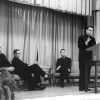calsfoundation@cals.org
Arkansas Council on Human Relations (ACHR)
A key facilitator in the desegregation of public schools and businesses in the state, the Arkansas Council on Human Relations (ACHR) was formed in December 1954 out of the reorganization of the board of the Arkansas branch of the grassroots organization, the Southern Regional Council. Initial funding came from a grant, via the Southern Regional Council, from the Ford Foundation, as well as the assistance of Fred K. Darragh Jr., a noted Arkansas agribusiness leader and philanthropist.
In the wake of the landmark 1954 Brown v. Board of Education of Topeka, Kansas decision, Nat Griswold, the first director, recognized two basic problems hampering efforts to desegregate Arkansas’s public facilities: white opposition to integration and political disunity among African Americans. The U.S. Supreme Court’s implementation order, known as Brown II (1955), allowed for school districts to move at their own pace in integrating schools, conceding that “local problems” might cause delay. This might have been a realistic assessment, but throughout the South, it encouraged white resistance to school integration.
The council’s first success in fostering desegregation occurred in the northeastern community of Hoxie (Lawrence County), where the school board voted to allow Black students to enroll in the formerly all-white high school. In 1955, the hastily formed Hoxie Citizens’ Council staunchly opposed the plan and allegedly threatened school board members. In turn, the Human Relations Council mobilized support for integration in Hoxie by appealing to sympathetic white leaders such as Forrest Rozell, executive secretary of the Arkansas Education Association, and E. B. Williams, an influential Methodist minister in Hoxie (and father of the poet Miller Williams). Most significantly, the state agency supplied legal counsel for Hoxie school board members. The Jonesboro (Craighead County) firm, Penix and Penix, secured a favorable ruling from a federal district court, which issued an injunction disallowing further interference from Hoxie’s segregationists. With virtually no media attention beyond a few favorable editorials in the Arkansas Gazette, the Arkansas Council on Human Relations had won its first significant victory.
During the 1957 Central High desegregation crisis, Little Rock (Pulaski County) school Superintendent Virgil T. Blossom refused to engage in a dialogue with the Human Relations Council, so the council—to its leadership’s dismay—did not play a substantive role. But the council effectively used the white community’s embarrassment over the national spotlight on Little Rock to begin, in the early 1960s, focusing on integrating businesses and public facilities while devoting attention to bolstering Black activism. The council invited William Hansen, white organizer of the Student Nonviolent Coordinating Committee (SNCC), to the state in an effort to mobilize the students at Little Rock’s all-Black Philander Smith College. In 1960, a spate of local sit-ins by Black college students resulted in harsh legal penalties, and this effectively silenced activism at Philander Smith. But with Hansen’s encouragement, Little Rock’s Black community began to insist on more than token integration. From 1961 to 1966, civil rights activist Ozell Sutton served as the council’s assistant director.
The resurgence of a vocal, more unified Black activism, coupled with the council’s efforts to negotiate integration with Little Rock’s white business leaders, led to a largely peaceful process of desegregating the city’s public spaces. Playing on fears that further resistance to civil rights would stifle economic development and investment, the council persuaded most white business owners to integrate quietly.
In 1974, the Arkansas Council on Human Relations merged with the Little Rock chapter of the Urban League. In its twenty-year history, the council effectively campaigned for interracial cooperation, greater Black employment opportunities, and the peaceful integration of public schools. It also pushed for prison reforms and improvements in public housing. The council fulfilled many of its goals, particularly by fostering the development of local Black leaders and facilitating desegregation.
For additional information:
Arkansas Council on Human Relations Papers. Special Collections. University of Arkansas Libraries, Fayetteville, Arkansas.
Kirk, John A. “Facilitating Change: the Arkansas Council on Human Relations, 1954–1964.”
———. Redefining the Color Line: Black Activism in Little Rock, 1940–1970. Gainesville: University Press of Florida, 2002.
Brent E. Riffel
University of Arkansas, Fayetteville
 Civil Rights and Social Change
Civil Rights and Social Change Education, Elementary and Secondary
Education, Elementary and Secondary Just Communities of Arkansas (JCA)
Just Communities of Arkansas (JCA) World War II through the Faubus Era, 1941 through 1967
World War II through the Faubus Era, 1941 through 1967




Comments
No comments on this entry yet.